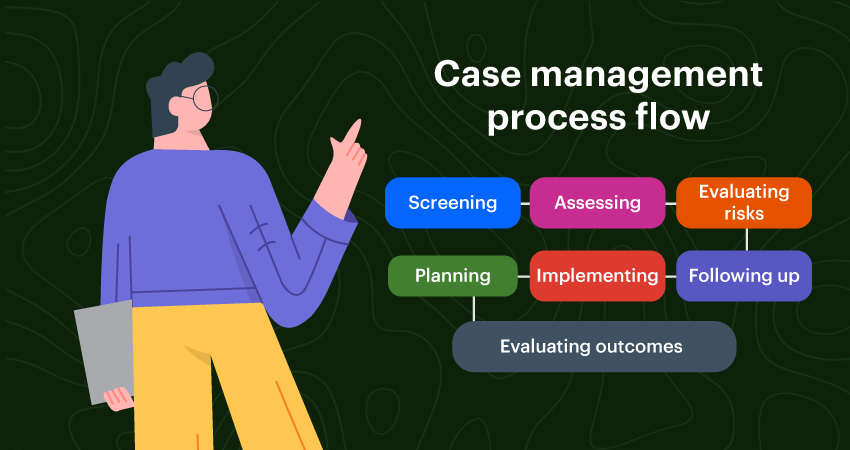Work can present challenging and complex problems, such as handling employee complaints or bug tracking. When a problem has a lot of moving parts, how do businesses ensure they are efficiently resolved? The answer is a case management process.
What is the case management process?
A case management process is a series of steps that resolve a case. It’s a way of turning a complex problem into a manageable workflow. Many industries use case management processes to solve various issues, such as:
- Processing tickets
- Bug Tracking
- Handling employee complaints
- Screening candidates
- Service requests
- Customer onboarding
- Complaints management
- Claims processing
A case manager oversees the case (ticket, complaint, bug) through a series of steps. This way, all the necessary information, and procedures are in one place under the management of one person or team. This is largely accomplished through software that organizes the case management workflow.
The steps in case management process provide a holistic view of a case from start to finish. It promotes efficiency, continuity, and clear communication. Without one in place, problems may go forgotten or unresolved.
Levels of Case Management Process
The workflow of a case management process can be broken down into seven levels:
- Screening
- Assessing
- Evaluating risks
- Planning
- Implementing
- Following up
- Evaluating outcomes
These steps are not necessarily linear, which means that a case manager may revisit earlier steps when necessary. For example, if a new problem arises during implementation, then it’s appropriate to return to planning. A case management steps process is robust enough to meet sudden changes in a complex case.
Case Management Process Steps
This section will break down each step in the case management process in more detail.
1. Screening
The first step in a case management process flow is to determine if the case needs the process at all. This prevents businesses from doing unnecessary work and keeps the system uncluttered.
For example, if you’re processing an employee complaint, the first step would be determining if the complaint is real. If it turns out to be a misunderstanding, the company saves precious time and avoids further miscommunication.
Another reason you screen cases is to decide if the case needs the process. If the problem is small, the business can resolve them instantly. This is key to working efficiently. There is no need to process a case if the problem can be solved in two minutes.
A case management process exists to solve complex problems that may last a long time, not for solving simple issues.
2. Assessing
In this step, a case manager will analyze the same information in the previous step, but to a greater depth. There is a key difference between screening and assessing. Screening is for determining if the case management process flow is necessary. Assessing is for accurately understanding the problem to provide an appropriate solution.
A case manager will talk with the client or employee and gather relevant information. The goal is to fully understand the case’s biggest needs. It’s important to listen closely and make the individual feel cared for. Case managers commonly have a rubric or questionnaire in place to make sure they’ve covered all the needed information.
3. Evaluating risks
After assessing a case, it’s time to evaluate the case’s risks. In some situations, managers will assign a case to a risk category. This helps the case manager prioritize cases and estimate the level of intervention each case requires.
Let’s say a technician receives two tickets. One ticket requests a small update to hardware and the other ticket says a hospital’s systems are down. It’s appropriate to prioritize the latter ticket and escalate the ticket if it’s beyond the technician’s abilities.
Evaluating risks allows the case manager to see the severity and urgency of each case. In turn, this will help with planning a solution that’s suited to the case.
4. Planning
With solid information in place, now the case manager must develop a plan. The purpose of planning is to answer the problems discovered in the assessment by establishing specific actions and goals, with these goals being the desired outcome of each action.
Here the case manager will choose methods and how and when to use them. For a case management example, if a case manager is handling an employee complaint, they may plan to use a company resource. They may consider calling a custodian, IT personnel, the legal department, or a higher-up.
Planning is a time to practice thoughtfulness and patience, as long as the case isn’t time-sensitive. Taking time to form a strategy will increase the chances that the plan will work.
Dynamic case management puts users in control
5. Implementing
In this step, the case manager carries out the plan created in the previous step. This entails the legwork of resolving a case – calling in professionals, attempting fixes, acquiring tools, making appointments, and whatever else the job may need.
Let’s say a human resources department hired a new employee. The case manager might arrange for IT to grant the new hire access to a computer. Then the case manager might assign a trainer to the new hire for six months.
During implementation, case managers should pay close attention to how effective their methods are.
6. Following-up
Once again, the case manager will analyze the problem. This time the goal is to see how effective implementation was. The case manager will contact the appropriate individual to collect information on the case and see if the problem still exists.
Let’s say a support person must help a customer resolve a bug. The support person calls a technician to visit the customer’s facility. The support person would later follow up by calling the customer to see if the technician visited and resolved the problem.
The case manager may determine that the plan of action needs to be adjusted or changed entirely. If so, then it’s back to the planning step. If new methods are implemented, the case manager will conduct additional follow-ups to see if the new strategies resolved the problem.
7. Evaluating outcomes
The last step in case management is about collecting feedback and analyzing key metrics about the case management process. This includes documenting the actions, results, quality, cost, and duration of the case handling process. Evaluating is an opportunity for clients, customers, and employees to give feedback on the system.
The case manager is ultimately generating a report to analyze the return on investment and the cost-benefit of the entire process. Then the findings are stored and distributed to key stakeholders. In turn, this improves the case management steps.
If ten new employees all express frustration with your business’s training program, it could mean it’s time to change training methods.
Evaluating outcomes can also help with future cases. If a new case is similar to a past case, the manager can avoid implementing strategies that didn’t work and focus on methods that did work.
Master the Steps of a Case Management Process
Kissflow workflow is a powerful tool to get the job done. Sometimes it’s even necessary. By breaking down a complex situation into case management process steps, businesses can work more efficiently and effectively.
Do you need a case management process tool?

